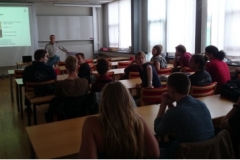 The Copenhagen DTU YM Section helped with arranging a talk, funded by the OSA student chapter and the Department of Photonics, named FUNlight. FUNlight served as an informal lecture in which bachelor students were invited to get a closer look at research being done at the department, with subsequent free food and beverages. An oral presentation was made by Kresten Yvind, group leader of Nanophotonic Devices, who talked about Nano lasers and tunable MEMS lasers for OCT applications.
The Copenhagen DTU YM Section helped with arranging a talk, funded by the OSA student chapter and the Department of Photonics, named FUNlight. FUNlight served as an informal lecture in which bachelor students were invited to get a closer look at research being done at the department, with subsequent free food and beverages. An oral presentation was made by Kresten Yvind, group leader of Nanophotonic Devices, who talked about Nano lasers and tunable MEMS lasers for OCT applications.
Directly following the FUNlight talk, students were given the opportunity for a lab tour both by the presenter as well as two EPS members: Ivan-Lazar Bundalo and Simone Gaiarin. They were thus given the opportunity to observe how cutting edge research equipment from different fields can actually look like in practice. The students, numbering around 20 people, were split in 3 groups and taken to 4 different labs from the fields:
- Optical chips (interconnects)
- Plastic fiber drawing tower
- Fiber Bragg Grating (FBG) fabrication and testing
- High-speed optical communications
In drawing tower lab students were introduced to the whole process of making plastic optical fibers (step index and microstructured). They could see different stages of fiber fabrication as well as most common problems related to that technology and the research focus areas. In FBG lab they were shown how phase mask technique can be used with UV laser light to make FBGs in microstructured fibers. Further on, they have been shown the principle of how fiber optic strain, humidity and temperature sensors work.
The high-speed optical communication lab is mostly focused on system type of experiments using a combination of stock fiber and newly developed specialty fibers acquired from OFS Fitel Denmark and NTT Photonics Laboratories. The basics of long-reach optical communication and imperfections causing problems in transmission systems were explained.
